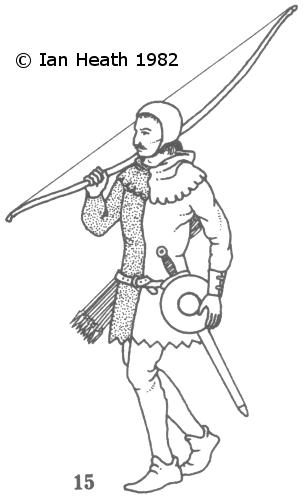
Create an Amazon Business Account
ENGLISH ARCHER c.1330-50
An extract from Armies of the Middle Ages, Volume 1by Ian Heath



15. ENGLISH ARCHER c.1330-50
This figure is based on 2 sources, a ‘Romance of Alexander’ variously dated at c. 1330-40, and an unfinished ms. of the late 1340s. Both show unarmoured archers in mi-parti liveries, the figure depicted here wearing a red/white tunic and hood plus blue-green hose, white arming cap and black shoes. Certainly uniformed (i.e., liveried) troops were fairly commonplace in England even before the commencement of the Hundred Years’ War, early references including a 200-strong contingent from Queen Isabella’s lands in 1327, siege engineers in 1333, troops from London in 1334 and a contingent of 600 archers under Sir Thomas Ughtred in 1335. The green and white uniforms worn by troops from Wales, Cheshire and Flint (spearmen as well as archers) from 1346 at the latest and throughout Edward III’s reign, are among the best-known early examples. They comprised a short coat and a hood (often mistakenly cited as a hat), green on the right and white on the left. By c.1330 at the latest the normal word for such identifiable liveries was secta, and archers were described as wearing the secta of their employers. Nevertheless, despite their uniform colours such liveries were probably inconsistent in cut and style from one man to the next since several documents could be inferred to mean that the men received only the cloth and were responsible for making it up into a uniform themselves.
The longbow with which these archers were armed remained unchanged throughout this era and right up until its official abandonment by the English army in 1595. It was about 6 feet in length (though a legal document of Edward II’s reign specifies 2 ells), varying slightly according to the height of the archer. Edward IV ordered that ‘every Englishman ... must have of his own a bow of his own height made of yew, wych or hazel, ash, laburnum, or any other reasonable timber’. Other sources record the principal woods used as yew (imported in particular from Spain and Italy), elm, hazel, ash and walnut. During the Hundred Years’ War bowyers were instructed on at least one occasion to make 4 bows of ash, elm or hazel to each one that they made of yew.
Arrows, on the other hand, could be made of as many as 15 different types of wood, though ash was clearly considered the best, while aspe (willow) was apparently regarded as unsatisfactory (despite the fact that it was apparently the principal wood used for arrows during Edward IV’s reign). Their length is hard to determine. Several orders specify an ell, but the ell was not a fixed unit of measurement and varied between 24-45 inches in Europe, the 45" ell being the English norm. Similarly the ‘clothyard’ sometimes referred to was an imprecise means of measuring, though it probably averaged about 37". Edward IV required arrows to be three-quarters of an (English) ell, or 33¾", while the only extant mediaeval arrow measures 30½"; the Tudor-period longbow arrows excavated in the Mary Rose measure more than 30". However, since it is a known fact that many archers cut their issued arrows down to suit their own draw, it seems probable that in practice arrows must have varied in length considerably. Arrowheads were largely of the bodkin variety, though barbed arrows were used against horses (as at Poitiers) and a type of broad arrow was used against ships’ rigging in naval battles. The flights of all such arrows were most commonly of grey goose feathers. Chaucer’s Yeoman had peacock flights to his arrows, but the 16th century toxophilite Roger Ascham considered these ‘a great vanity’ that was ‘taken up for gayness’. Nevertheless, many contemporary 14th-15th century sources refer to peacock-feathered arrows.
It is evident from surviving orders for bows and arrows that, in Edward III’s reign at least, each archer started out on campaign with 3 or 4 sheaves of arrows, and the barest minimum with which he entered battle was a single sheaf of 24 arrows (see also note 17). Provision of bow-strings (or ‘arrow-strings’ as they were actually called) was apparently 3 per bow plus further spares in the baggage.